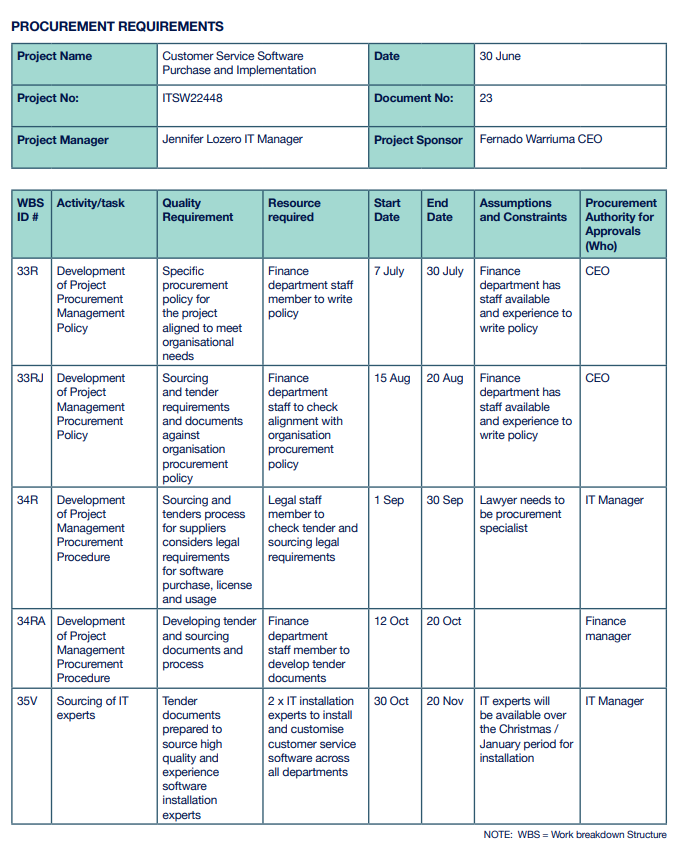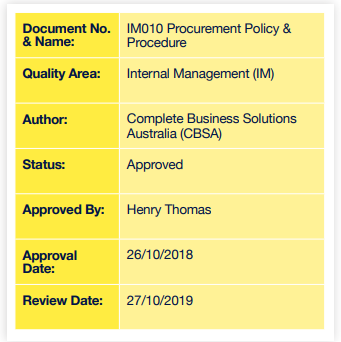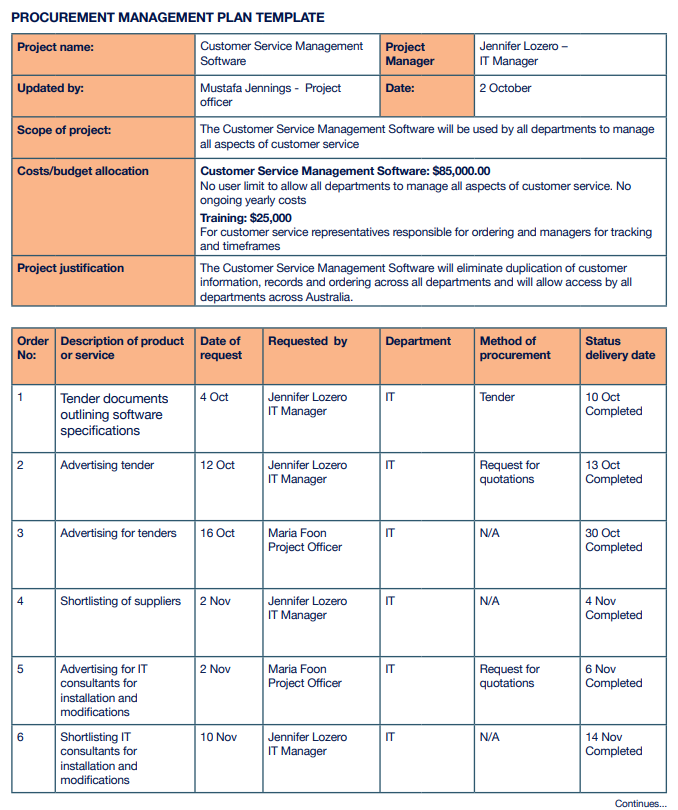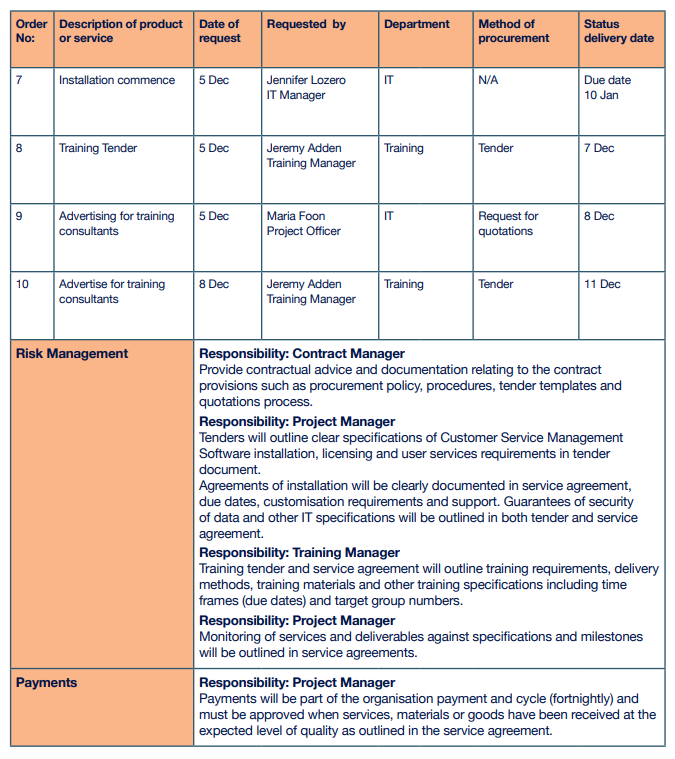Most organisations have various projects they undertake during a year. Some projects may be simple and short-term, while others may be larger, more complex and over a longer duration.
Project team members are assigned various project roles and have certain duties they must perform throughout the duration of the project, and this includes assisting in the planning and managing of procurement processes.
In this topic, we will examine the concept and definition of procurement and examine the process of planning procurement prior to the commencement of the project and the development of the procurement management plan.
By the end of this topic, you will understand:
- The term procurement
- How to assist with establishing the project procurement requirements
- How to assist with the development of a procurement-management plan and documentation.
Procurement is a formal procedure that is used to source and purchase goods and services from an external provider. Many large organisations, including federal and state government departments, have clearly defined procurement policies and procedures that outline the process that should be undertaken when sourcing an external provider of various materials, goods and services.
For example, the Australian Government’s Department of Finance outlines its process of obtaining goods and services on its website, including information on:
- Procurement Policy and Procurement Rules
- Buying for Government
- Whole of Government Procurement
- AusTender—Provides information for external providers, tender opportunities and information on annual procurement plans
- ICT procurement—Provides a link to the Digital Transformation Agency that is responsible for all Information and Communications Technology procurement.
The procurement process of a particular project may use the same policies and procedures that are currently in place and as outlined by the organisation, or the project manager may request the development of project-specific procurement processes.
Case Study

Keenan Brothers is a small construction company that specialises in commercial buildings, including wide-span warehouses. The company was founded by three brothers from the Keenan family, who come from a long line of family builders. The brothers are great builders, but they have lost money in the past on certain projects as they did not have clear processes for sourcing and obtaining the right materials, goods and services at specific time frames of a project. They have appointed a new CEO that quickly developed and introduced a procurement policy and procedure that clearly documents the procurement process and allows the organisation to:
- Source competitive and sustainable materials, goods and services
- Provide the required information on how to negotiate and manage vendors and suppliers
- Strategically select local materials, goods and services
- Outline the process for approving the companies purchase requests
- Describe the process of receiving materials, goods and services.
The introduction of the procurement process has saved the construction company money as they have been able to negotiate more favourable terms and pricing. It has also led to the use of a higher quality supplier that has delivered on time and therefore saved on delays in project construction.
Further Reading
Read the following article by Julie Young for Investopedia on the definition of procurement: ‘Procurement’
Further information on procurement in the federal government can be found on the Department of Finance website: ‘Procurement’
Projects usually require external sourcing and purchasing to meet their project goals and objectives. To establish the project procurement requirements, the project manager and other project team members must work in collaboration with a variety of stakeholders including the finance department. The project procurement requirements may include:
- Listing the various procurement activities and tasks
- Considering quality and quantity requirements
- Identifying specific resource requirements including any supply and delivery requirements for supplies, goods and materials
- Determining start and end dates
- Describing any assumptions and constraints
- Outlining who approves the procurement requirement.
The following completed template is an example of how procurement requirements can be documented for a particular project.

Other procurement requirements
Other procurement requirements may include:
- Product and service definitions
- Quality and or technical specifications
- Resource identification (e.g., people, materials, equipment)
- upply and delivery requirements
- Supply and engagement metrics, including:
- Employment equity Environmental
- Intellectual property legal
- Licences, permits and certifications Security
- Work health and safety (WHS)
- Work breakdown structure.
Procurement documentation requirements
Procurement documentation requirements may include:
- Assets and disposal actions
- Contract planning, formation and negotiation
- Administration records
- Procurement logs and registers
- Quotes, invoices and receipts
- Supplier lists
- Test and acceptance results.
Procurement policies and procedures may need to be developed as part of the procurement requirements for a particular project.
Example
The following example is the CBSA procurement policy:
Purpose
This policy is designed to provide mandatory requirements for Complete Business Solutions Australia’s (CBSA) staff in relation to the purchase of goods and services.
Policy Objectives
The objectives of this policy and procedure are to:
- Obtain value in the expenditure for goods and services
- Ensure ethical and fair treatment of participants
- Ensure probity, accountability and transparency in purchasing operations
- Ensure sustainability forms part of the selection process.
Procedures
For purchases less than $200
- No quote from suppliers is required
- A Procurement Management Plan is not required, and no formal approval is required
- No risk identification is required
- No contract is required.
For purchases greater than $200
- A Procurement Management Plan is required to be completed and approved by the General Manager
- A minimum of three quotes must be sought from suppliers, with one quote being sought from a local supplier (if possible) using the Request for Quote Template
- Evaluation should be documented in the Procurement Evaluation Template using the following selection criteria:
- Quality (Technical capability)
- Sustainability
- Value for money / price
- The Goods and Service Contract Template should be used for the contractual agreement between CBSA and the supplier.
Related Documents
The following are related to this policy and procedure:
- Risk Management Policy & Procedures
- Procurement Management Plan
- Request for Quote Template
- Procurement Evaluation Template
- Goods and Services Contract Template.
Document Control


The procurement management plan outlines how a particular project will conduct its procurement process. The procurement management plan may also be incorporated into the project schedule for the delivery of certain materials, goods and services. The project manager oversees and manages all aspects of the project, the procurement plan and processes, as well as managing the project schedule, budget and project risks.
Other managers, such as information technology managers, may determine the statement of work and usually oversee and manage the technical requirements of any contractors or service providers.
The components of a Procurement Management Plan may include the following:
- Description of product or service
- Date of request
- Who has requested the goods or services Department
- Costs or budgets
- The method of procurement Status
- Delivery date and project schedule requirements
- Prequalified vendors through shortlisting of tender applications
- Roles and responsibilities
- Risk management
- Monitoring and managing vendors, suppliers and contractors.
Other considerations in the procurement management plan may include the following:
- Acquisition criteria
- Contract Administration
- Contract closure processes
- General conditions of the contract
- Organisational procurement policy and procedures
- Preferred suppliers
- Procurement-management processes
- Procurement statements of work
- Product and quality specifications
- Project resource requirements
- Supplier selection criteria
- Statement of works.
The development of the project procurement management plan usually involves other identified roles to assist with the development of the procurement management plan and for the procurement process to run smoothly. These may include:
Organisational senior managers and executives to provide advice and decision-making for contractual issues. They include the CEO, contract managers, IT managers and finance managers. The senior managers may also assist with the development, review and approval of tender documents and contract documents.
The legal team may provide advice relating to legal requirements in documents such as tender documents, contract documents or service agreements.
In some cases, the roles may overlap, and it is important to ensure that the procurement management plan (where required) defines the responsibilities for each of the roles. An example of a procurement management plan for the previous example of the installation and customisation of Customer Service Management Software is provided below:


Documentation that may be required for the procurement management plan may include the following:
- Request for tender document
- Quotation form
- Request for services form or requests for quotation (RFQ)
- Requests for tender (RFT)
- Statements of work
- Procurement process flowcharts
- Contracts and types (e.g., fixed term, fixed price, milestone payments)
- Procurement risks assessment and mitigation plan (see example below)
- Project schedules for milestones in the procurement process.
| Risk Description | Likelihood and Impact | Mitigation Strategies |
|---|---|---|
| Tender documents sent to bidders at different times. Gives earlier bidders more time to prepare and disadvantages other bidders | Medium ikelihood, high impact | Issue tender documents at the same time for all bidders |
| Conflict of interest - if one team member can make decisions on selection of tender process and knows bidders | Low likelihood, high impact | Ensure procurement team and project manager are involved at each stage or procurement process. Invite technical manager to join tender shortlist and selection panel |
Watch
Watch the following YouTube video by Demand Metric that provides information on procurement management planning: ‘Procurement Management Plan Template.’
Further Reading
Read the following article by Concord to learn more about the process of developing a procurement management plan: ‘Procurement Management Plan in 10 St.eps.’
Read the following article by BIT.AI Blog on the process of developing a procurement management plan: ‘Procurement Management Plan: What is it & How to Create? (Steps Included)
Quiz

